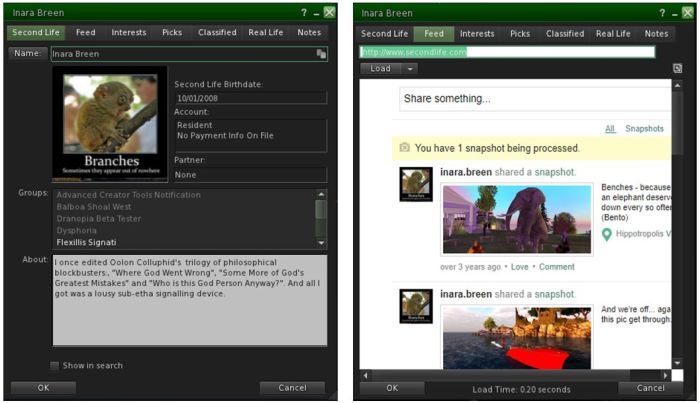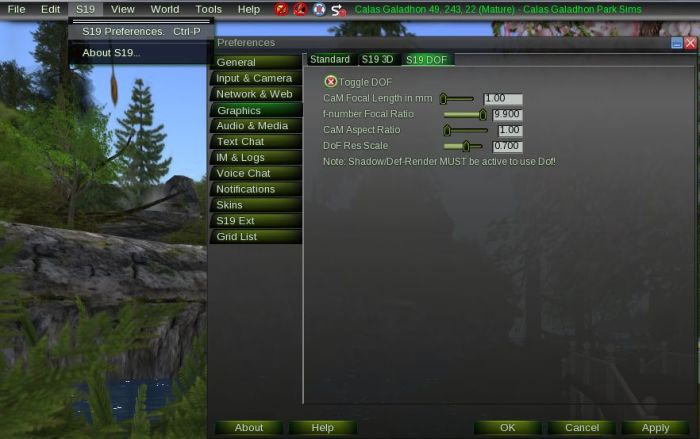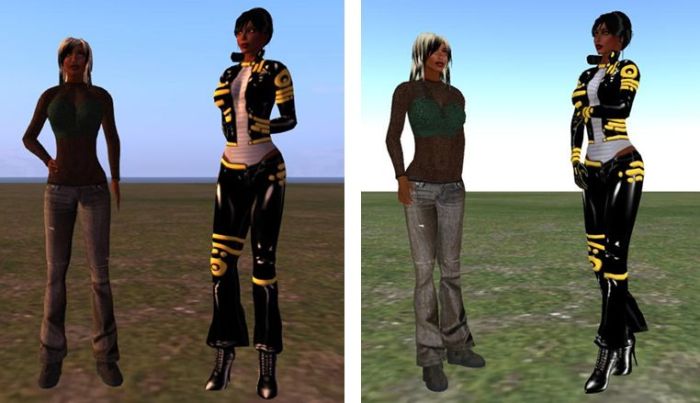 Thursday, September 28th, 2022 saw the release of Kirsten’s Viewer S23 Build 1725 (what a pity build 1701 was a preview – it would have been Enterprise-ing to have a full release like this with all that is packed into it, go out with that ionic number! 😀 ).
Thursday, September 28th, 2022 saw the release of Kirsten’s Viewer S23 Build 1725 (what a pity build 1701 was a preview – it would have been Enterprise-ing to have a full release like this with all that is packed into it, go out with that ionic number! 😀 ).
While there was an earlier preview release, Build 1725 (initially 1705) – code-named Arcane – marks the first full release of Kirsten’s viewer in over a year – and brings to culmination a lot of hard work on Kirsten’s part in completely overhauling the viewer from stem-to-stern as well as incorporating the latest updates from Linden Lab.
Linden Lab Updates
Given the span of times between this release and the last, there have been numerous de facto viewer releases from the Lab such that listing them all here would simply read as a telephone directory of viewer version numbers and names. However, among that list there are some significant releases worth referencing as now being reflected in Kirsten’s Build 1725:
- LLModalDialog() crash hotfix viewer, version 6.6.4.575022, September 2022
- Profiles Viewer, version 6.6.3.574158, August 2022.
- Performance Improvement viewer, version 6.6.0.571939, May 2022.
- Multi-Factor Authentication (MFA) viewer, version 6.5.5.571282, May 2022.
- Cache+ 360 Capture viewer, version 6.5.1.566335, December 2021.
- Viewer UI updates, version 6.4.20.560520, June 2020.
All of which means that Kirsten’s viewer is bang-slap up-to-date with the Lab’s official release viewer code-base at the time of writing this overview.
For many, the chief updates in the above list will be the Performance Improvements, which (as with other viewers incorporating the Lab’s improvements) bring a significant FPS boost to most systems – notably with ALM enabled, but frequently with ALM+Shadows enabled); together with the 360-degree snapshot capability.
Performance Improvements / Changes
The Performance improvements contained within Kirsten’s 1725 actually break down into two categories:
- The primarily under-the-hood improvements from Linden Lab which come via the Performance Improvements viewer as defined above,
- The Graphics Improvements developed by Beq Janus and first released in Firestorm 6.5.3 in March 2022. These were submitted to Linden Lab and have been incorporated into the Performance Floater / Auto FPS t viewer, which at the time of writing this article was at project viewer status, and from which they have been pulled into Kirsten’s S23 1725.
Those wishing to take a deeper look at the Graphics Improvements floater and its options can do so via my Firestorm 6.5.3 review – but please note that while the functionality present within Firestorm is largely the same as for the official viewer /Kirsten’s viewer, the layout of the floater is slightly different. For completeness, the following is just a brief outline of the floater and its panels as found within the official viewer / Kirstens viewer:

- Your current frame rate, which can be adjusted through changes in the Graphics Settings panel. Note that my FPS is shown as running at a maximum of 60 FPS as I have Vsync enabled, which limits frame rates to the screen refresh rate (60 Hz).
- Displays the most commonly-used graphics settings (but not all – the Vsync option, for example, is absent and must be accessed via Preferences→Graphics) which can impact frame rates.
- Lists all the avatars your viewer is currently rendering, and presents the time is takes to render them in microseconds (µs – a millionth of a second).You can use this panel to select individual avatars and select whether or not they are always fully rendered or never fully rendered.
- Provides a breakdown of your avatar’s attachments and their render time / cost, and allows you to remove “laggy” items.
- Provides a breakdown of your avatar’s HUD attachments and their render time / cost, and allows you to remove “laggy” items.
- Presents the “Auto FPS” capability (several of the options found in the top bar of the Firestorm version of the floater as described in my review above) together with distance settings for rendering avatars in full detail and between which the auto-FPS will attempt to function.
Kirsten’s Viewer Updates
Build 1725 also includes a lot of changes from Kirsten as well. This can be split between the “visible” and the the under-the-hood, which together add up to a lot of work on Lee’s part to completely overhaul the viewer’s code and add multiple subtle but worthwhile changes.
The visible updates include:
- Use use of gradients in floaters an panels to add a “softness” to them which helps them feel more a part of the viewer and the rendered scene behind, rather than sitting like a floating rectangle completely obscuring the view beyond.
- Subtle, but appreciable updates to some – but not all – of the toolbar button icons.

- A refactoring of the AO floater to clean-up issues of buttons overlaying text within the panel.
- 1725 offers three new viewer skinning options:
- Linden – speaks for itself, for those who prefer the look of the official viewers.
- Pewter – the default, and a really nice take on the colour of the odd 1.23.x viewer series offering a soft pewter blue which is easy on the eye.
- Jinx – a more lavender / purple finish semi-mindful of Kokua without replicating it.
Film Menu

In short, this brings together options from other menus and Preferences, as will as supplying some custom options, designed to make recording machinima / taking photos easier. These range from the basic hide / show UI elements / HUDs through to adjusting shaders and those nifty options for adjusting how your SpaceNav mouse responds / influences avatar behaviour.
This menu may not be as comprehensive as the likes of similar options from in Black Dragon or the PhotoTools UI option within Firestorm, but it is still a good selection of functions and toggles that can be easily called up when filming / photographing a scene – although as a photographer myself, I’d perhaps like to see a few additions to make the menu a little more usable to those of us (the majority?) who prefer to take stills shots (e.g. the ability to de-render all avatars from a landscape shot, for example). But this is a minor point.
Under-the-Hood
The core amount of work carried out in this build has been the merging with the latest LL code-base, and a major overhaul of the code by Kirsten, as noted in the release description:
Anaglyph Render refactored … System detection totally rewritten to interrogate kernel (not registry or using manifests). Days and Days removing old code and going line by line improving performance. And I seriously mean that analysing each if/else statement and function for even the most minute tweak.
Finally, this is built with full optimisation and link time code generation.
Feedback
Kirstens Viewer has always offered good performance and crisp rendering, and the incorporation of the Lab’s updates (and those modified from Firestorm), together with the work put in by Kirsten in refactoring the code means that S23 1725 is one of the slickest performing viewers I’ve used – although I have little doubt it would not find favour among some SL users due to the lack of RLV or RLVa support, which is a shame.
On a personal note, I do like the new skinning options that come with 1725 – the “old” green default was to me a little too vibrant, whereas the Pewter is a lot easier on the eyes. However, I have been conflicted over the use of gradients on the drop-down menus. As noted above, the use of gradients on floaters and their panels works well, but their use in the menus might make menu options harder to see for those with vision impairments.
But, that said, there is no doubt that 1725 is an excellent update to Kirsten’s Viewer, and one that will hopefully put the viewer in a position where it an more readily keep pace with updates from Linden Lab & adopt new features (and those deemed suitable coming out of other TPVs) going forward.















